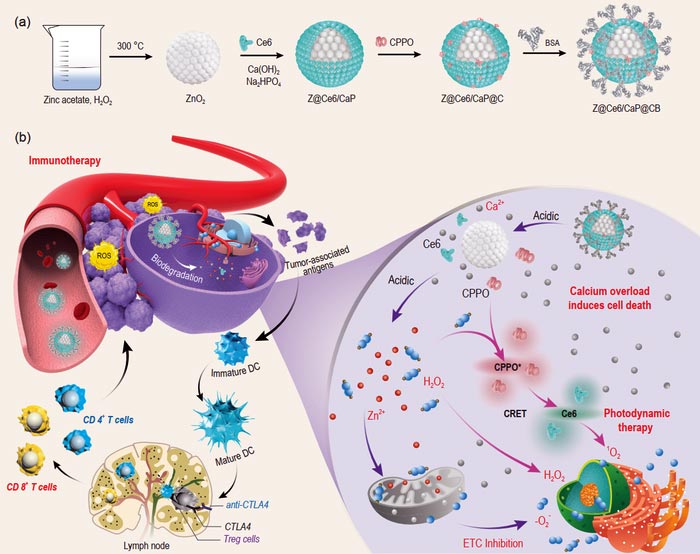Cascade-responsive nanobomb for anti-tumor synergistic therapies

(a) Synthesis process of ZnO2@Ce6/CaP@CPPO/BSA (Z@Ce6/CaP@CB). (b) Schematic illustration of the mechanism of Z@Ce6/CaP@CB-based synergistic therapy. Z@Ce6/CaP@CB nanobombs can trigger multiple ROS storms (H2O2, 1O2, and •O2-) and Ca2+ overload-induced cell death through a cascade reaction without external energy activation and effectively activate the systemic immune response while inhibiting the growth of primary tumors.
Credit: ©Science China Press
Reactive oxygen species (ROS) can act as signal carriers during the evolution of malignant tumors. At the appropriate concentration, ROS mediate signal transduction and cell growth. However, ROS are a double-edged sword, as excessive ROS can oxidize proteins, damage the DNA structure, and induce cell apoptosis. Moreover, ROS can induce inflammation at the tumor site, which further improves tumor immunogenicity.
Therefore, increasing the content of ROS in tumor sites has become an effective method for cancer therapy. At present, the ways to generate ROS through external stimulations, such as photodynamic reaction, sonodynamic reaction, and radiation sensitization, are greatly limited by the penetration depth of the laser, irradiation range of external excitation, and safety concerns of the radiation.
In response to these problems, chemodynamic therapy has been developed, which has received widespread attention. Chemodynamic therapy uses excess H2O2 in the tumor microenvironment without external energy stimulation to generate ROS through the Fenton reaction.
However, the current therapeutic effect of chemodynamic therapy is not satisfactory, because the initiation of an efficient Fenton reaction requires harsh acidic conditions and excess H2O2. In addition to exogenous ROS production strategies, increasing the generation of endogenous ROS to inhibit tumor growth is another promising approach. It is well known that inhibiting the mitochondrial electron transport chain can enhance the generation of ROS.
However, treating cancer only by increasing endogenous ROS is unsatisfactory, as it is difficult to effectively inhibit tumor growth with a low amount of produced endogenous ROS. Therefore, developing strategies for the selective generation of sufficient ROS without external energy stimulation under mild in vivo conditions remains a huge challenge in the field of cancer therapy.
In a new research article published in the Beijing-based National Science Review, scientists at the Changchun Institute of Applied Chemistry, Chinese Academy of Sciences, China, designed a cascade-responsive ROS generation device with domino effect and without external stimulation for the specific generation of multiple severe ROS storms at the tumor site. Co-authors Yang Liu, Yinghui Wang, Shuyan Song and Hongjie Zhang find that the simple introduction of the prepared ZnO2@Ce6/CaP@CPPO/BSA nanobomb into the tumor would cause a “domino effect”, which could trigger the production of multiple ROS storms and Ca2+ overload, as well as effectively activate the systemic immune response while inhibiting the growth of primary tumors. Moreover, tumor metastasis can be effectively prevented by adjuvant treatment with anti-CTLA4 checkpoint blockers.
This research received funding from the National Natural Science Foundation of China, the Strategic Priority Research Program of the Chinese Academy of Sciences, and the Youth Innovation Promotion Association of Chinese Academy of Sciences.
See the article:
Yang Liu, Yinghui Wang, Shuyan Song, and Hongjie Zhang
Cascade-responsive nanobomb with domino effect for anti-tumor synergistic therapies
National Science Review, 2021, nwab139, https://doi.org/10.1093/nsr/nwab139
Journal: National Science Review
DOI: 10.1093/nsr/nwab139
All latest news from the category: Life Sciences and Chemistry
Articles and reports from the Life Sciences and chemistry area deal with applied and basic research into modern biology, chemistry and human medicine.
Valuable information can be found on a range of life sciences fields including bacteriology, biochemistry, bionics, bioinformatics, biophysics, biotechnology, genetics, geobotany, human biology, marine biology, microbiology, molecular biology, cellular biology, zoology, bioinorganic chemistry, microchemistry and environmental chemistry.
Newest articles

Sensitive ceramics for soft robotics
Most people think of coffee cups, bathroom tiles or flower pots when they hear the word “ceramic”. Not so Frank Clemens. For the research group leader in Empa’s Laboratory for…

‘Entirely unanticipated’ role of protein netrin1 in spinal cord development
Known for its axon guidance properties, new research suggests protein is critical in guiding neural development. Scientists at the Eli and Edythe Broad Center of Regenerative Medicine and Stem Cell Research…

AI to improve brain cancer diagnosis, monitoring, treatment
Recommendations published in The Lancet Oncology call for good clinical practice of new technologies to modernize decades-old standard of care for brain cancer patients. An international, multidisciplinary team of leading…



